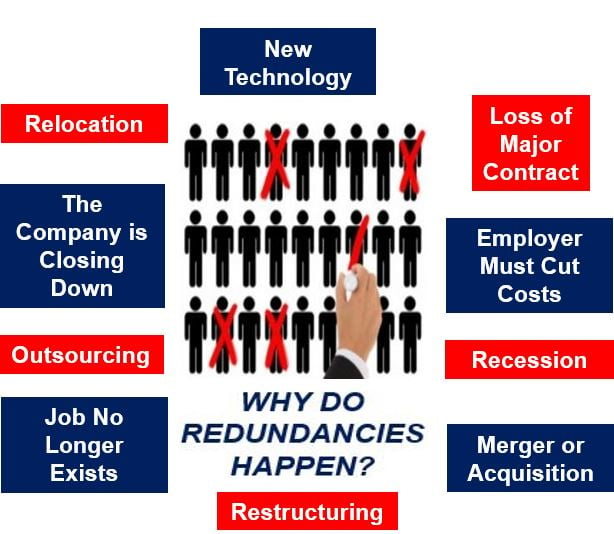Your Rights to Redundancy If Company Goes Bust: UK Employee Protections
Your Rights to Redundancy If Company Goes Bust: UK Employee Protections
Blog Article
Checking Out the Interplay In Between Firm Redundancy and Business Adaptability for Future Development
In the vibrant landscape of today's business globe, the elaborate relationship in between firm redundancy and business versatility emerges as a critical factor for sustained growth and success. Companies often face the obstacle of striking a fragile equilibrium between maintaining a level of redundancy to reduce dangers and cultivating versatility to respond quickly to the ever-evolving market needs.
Significance of Firm Redundancy
Business redundancy is a crucial aspect that improves organizational durability and minimizes operational dangers. By incorporating redundancy procedures within the organizational structure, companies can much better endure unforeseen disturbances and changes in business setting. Redundancy works as a critical buffer, allowing firms to adjust and respond efficiently to unexpected difficulties without jeopardizing crucial operations.
One secret aspect of the importance of firm redundancy is its duty in ensuring connection throughout times of dilemma. When confronted with unexpected changes or emergency situations, redundant systems, sources, or workers can tip in to preserve vital features and stop extensive disturbances. This connection not only safeguards the business's reputation and consumer count on yet additionally minimizes financial losses and operational downtime.

Approaches for Business Versatility

Developing adaptable organizational frameworks that allow for quick modifications to market characteristics and customer needs is essential for staying competitive in a quickly progressing environment. By proactively identifying prospective interruptions and possibilities, companies can proactively flourish and adjust in an ever-changing service next landscape.
Balancing Redundancy and Adaptability
Attaining a harmonious stability in between operational redundancy and organizational flexibility is vital in browsing the intricacies of a dynamic business atmosphere. Redundancy within a company provides a safety internet, ensuring connection and stability in procedures. Nevertheless, an extra of redundancy can lead to inadequacies and hinder versatility to altering market problems. On the other hand, business flexibility enables companies to react without delay to outside disturbances and seize new opportunities. Striking the ideal equilibrium between redundancy and adaptability is a fragile procedure that needs a deep understanding of the organization's objectives, market characteristics, and threat tolerance.
To accomplish this balance, firms require to carry out normal assessments of their operations to determine areas where redundancy is required for risk reduction and where flexibility can drive innovation and development. Carrying out flexible frameworks, promoting a society of constant understanding and renovation, and encouraging open interaction across all levels of the company are vital approaches to harmonize redundancy and versatility successfully. By aligning these two critical aspects, companies can place themselves for sustainable growth and success in an ever-changing company landscape.
Situation Studies on Adjustment Success
In analyzing circumstances of effective business adjustment, it becomes evident that the interaction in between functional redundancy and flexibility is a defining aspect in shaping resilient businesses. A DVD rental service, Netflix demonstrated exceptional versatility by transitioning right into a streaming platform when digitalization interrupted the sector. These instance researches underscore the significance of operational redundancy coupled with organizational versatility in fostering long-lasting development and competition.
Building Resilience for Future Development
Structure durability for future growth calls for a critical alignment of operational discover here processes with market characteristics and arising fads. Companies need to adapt to changing atmospheres by cultivating a culture of flexibility, innovation, and constant enhancement.
Additionally, promoting strong partnerships with stakeholders, such as customers, employees, vendors, and the community, is vital for preserving and weathering unpredictabilities trust and assistance during rough times. Reliable interaction and transparency play an important duty in structure strength, as they assist promote and straighten expectations partnership in navigating unpredictabilities.
Moreover, companies need to focus on learning and advancement efforts to upskill employees and equip them with the essential tools to adapt to changing circumstances. By buying their workforce, business can improve their versatility and agility, ultimately reinforcing their durability for sustainable future development.
Final Thought

In the dynamic landscape of today's service globe, the intricate connection between company redundancy and business versatility emerges as a crucial factor for sustained development and success. Firms commonly encounter the challenge of striking a fragile balance in between preserving a degree of redundancy to alleviate dangers and fostering adaptability to respond promptly to the ever-evolving market needs.To achieve this balance, companies need to carry out normal assessments of their operations to identify locations where redundancy is essential for threat reduction and where versatility can drive innovation and development.In final thought, the interplay in between firm redundancy and organizational adaptability check this is vital for future development. Structure strength with a mix of redundancy and versatility will ensure that firms are prepared for the difficulties of the future.
Report this page